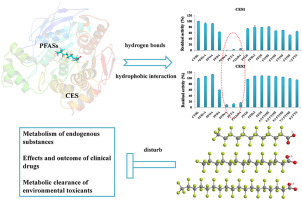当前位置:
X-MOL 学术
›
Environ. Pollut.
›
论文详情
Our official English website, www.x-mol.net, welcomes your feedback! (Note: you will need to create a separate account there.)
Per- and polyfluoroalkyl substances exert strong inhibition towards human carboxylesterases.
Environmental Pollution ( IF 8.9 ) Pub Date : 2020-04-04 , DOI: 10.1016/j.envpol.2020.114463 Yong-Zhe Liu 1 , Li-Hua Pan 2 , Yu Bai 3 , Kun Yang 1 , Pei-Pei Dong 4 , Zhong-Ze Fang 1
Environmental Pollution ( IF 8.9 ) Pub Date : 2020-04-04 , DOI: 10.1016/j.envpol.2020.114463 Yong-Zhe Liu 1 , Li-Hua Pan 2 , Yu Bai 3 , Kun Yang 1 , Pei-Pei Dong 4 , Zhong-Ze Fang 1
Affiliation

|
PFASs are highly persistent in both natural and living environment, and pose a significant risk for wildlife and human beings. The present study was carried out to determine the inhibitory behaviours of fourteen PFASs on metabolic activity of two major isoforms of carboxylesterases (CES). The probe substrates 2-(2-benzoyl-3-methoxyphenyl) benzothiazole (BMBT) for CES1 and fluorescein diacetate (FD) for CES2 were utilized to determine the inhibitory potentials of PFASs on CES in vitro. The results demonstrated that perfluorododecanoic acid (PFDoA), perfluorotetradecanoic acid (PFTA) and perfluorooctadecanoic acid (PFOcDA) strongly inhibited CES1 and CES2. The half inhibition concentration (IC50) value of PFDoA, PFTA and PFOcDA for CES1 inhibition was 10.6 μM, 13.4 μM and 12.6 μM, respectively. The IC50 for the inhibition of PFDoA, PFTA and PFOcDA towards CES2 were calculated to be 9.56 μM, 17.2 μM and 8.73 μM, respectively. PFDoA, PFTA and PFOcDA exhibited noncompetitive inhibition towards both CES1 and CES2. The inhibition kinetics parameters (Ki) were 27.7 μM, 26.9 μM, 11.9 μM, 4.04 μM, 29.1 μM, 27.4 μM for PFDoA-CES1, PFTA-CES1, PFOcDA-CES1, PFDoA-CES2, PFTA-CES2, PFOcDA-CES2, respectively. In vitro-in vivo extrapolation (IVIVE) predicted that when the plasma concentrations of PFDoA, PFTA and PFOcDA were greater than 2.77 μM, 2.69 μM and 1.19 μM, respectively, it might interfere with the metabolic reaction catalyzed by CES1 in vivo; when the plasma concentrations of PFDoA, PFTA and PFOcDA were greater than 0.40 μM, 2.91 μM, 2.74 μM, it might interfere with the metabolic reaction catalyzed by CES2 in vivo. Molecular docking was used to explore the interactions between PFASs and CES. In conclusion, PFASs were found to cause inhibitory effects on CES in vitro, and this finding would provide an important experimental basis for further in vivo testing of PFASs focused on CES inhibition endpoints.
中文翻译:

全氟和多氟烷基物质对人的羧酸酯酶具有很强的抑制作用。
PFAS在自然和生活环境中都具有高度持久性,对野生动植物和人类构成重大风险。本研究旨在确定14种PFAS对两种主要的羧酸酯酶(CES)亚型的代谢活性的抑制作用。CES1的探针底物2-(2-苯甲酰基-3-甲氧基苯基)苯并噻唑(BMBT)和CES2的荧光素二乙酸酯(FD)用于确定PFAS在CES上的体外抑制潜力。结果表明,全氟十二烷酸(PFDoA),全氟十四烷酸(PFTA)和全氟十八烷酸(PFOcDA)强烈抑制CES1和CES2。PFDoA,PFTA和PFOcDA对CES1的半抑制浓度(IC50)值分别为10.6μM,13.4μM和12.6μM。抑制PFDoA的IC50,计算得出的针对CES2的PFTA和PFOcDA分别为9.56μM,17.2μM和8.73μM。PFDoA,PFTA和PFOcDA对CES1和CES2均表现出非竞争性抑制作用。PFDoA-CES1,PFTA-CES1,PFOAc-CES1,PFDoA-CES2,PFTA-CES2,PFOAcDA-CES2的抑制动力学参数(Ki)为27.7μM,26.9μM,11.9μM,4.04μM,29.1μM,27.4μM分别。体外-体内外推法(IVIVE)预测,当PFDoA,PFTA和PFOcDA的血浆浓度分别大于2.77μM,2.69μM和1.19μM时,可能会干扰CES1在体内催化的代谢反应; 当PFDoA,PFTA和PFOCDA的血浆浓度大于0.40μM,2.91μM,2.74μM时,可能会干扰CES2在体内催化的代谢反应。分子对接用于探索PFAS与CES之间的相互作用。总之,发现PFAS在体外对CES具有抑制作用,这一发现将为进一步体内测试CES抑制终点的PFAS提供重要的实验基础。
更新日期:2020-04-06
中文翻译:

全氟和多氟烷基物质对人的羧酸酯酶具有很强的抑制作用。
PFAS在自然和生活环境中都具有高度持久性,对野生动植物和人类构成重大风险。本研究旨在确定14种PFAS对两种主要的羧酸酯酶(CES)亚型的代谢活性的抑制作用。CES1的探针底物2-(2-苯甲酰基-3-甲氧基苯基)苯并噻唑(BMBT)和CES2的荧光素二乙酸酯(FD)用于确定PFAS在CES上的体外抑制潜力。结果表明,全氟十二烷酸(PFDoA),全氟十四烷酸(PFTA)和全氟十八烷酸(PFOcDA)强烈抑制CES1和CES2。PFDoA,PFTA和PFOcDA对CES1的半抑制浓度(IC50)值分别为10.6μM,13.4μM和12.6μM。抑制PFDoA的IC50,计算得出的针对CES2的PFTA和PFOcDA分别为9.56μM,17.2μM和8.73μM。PFDoA,PFTA和PFOcDA对CES1和CES2均表现出非竞争性抑制作用。PFDoA-CES1,PFTA-CES1,PFOAc-CES1,PFDoA-CES2,PFTA-CES2,PFOAcDA-CES2的抑制动力学参数(Ki)为27.7μM,26.9μM,11.9μM,4.04μM,29.1μM,27.4μM分别。体外-体内外推法(IVIVE)预测,当PFDoA,PFTA和PFOcDA的血浆浓度分别大于2.77μM,2.69μM和1.19μM时,可能会干扰CES1在体内催化的代谢反应; 当PFDoA,PFTA和PFOCDA的血浆浓度大于0.40μM,2.91μM,2.74μM时,可能会干扰CES2在体内催化的代谢反应。分子对接用于探索PFAS与CES之间的相互作用。总之,发现PFAS在体外对CES具有抑制作用,这一发现将为进一步体内测试CES抑制终点的PFAS提供重要的实验基础。


























 京公网安备 11010802027423号
京公网安备 11010802027423号